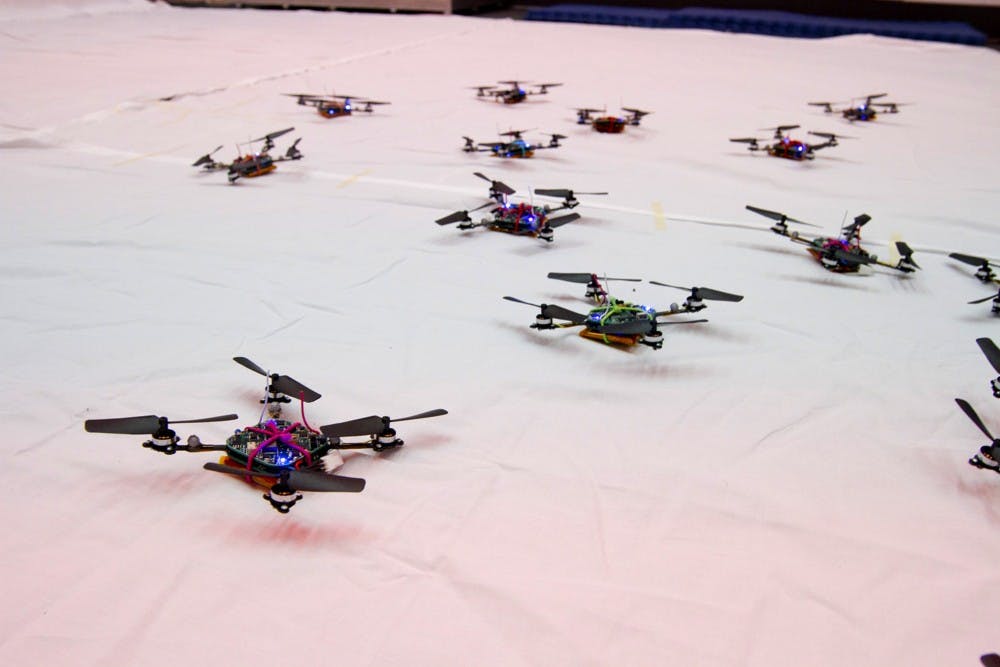
At Penn’s General Robotics, Automation, Sensing and Perception Laboratory, some professors and students are applying their skills to the study of swarming robots.
Deputy Dean for Education in the School of Engineering and Applied Science Vijay Kumar has helped lead the recent creation of a number of “quadrotors.”
According to Kumar, quadrotors are flying robots that come equipped with four rotors, or four rotating blades. There are small, medium and large sizes for the quadrotors.
At the national Technology, Education, Design conference held late last month, Kumar shared a video of the quadrotors playing the James Bond theme.
Since that time, the video that is hosted on TED’s website has received more than 790,000 views.
However, according to Kumar, quadrotors can serve a number of purposes beyond simply playing the James Bond theme.
For example, they can be used to help in rescue operations during natural disasters and to map a closed environment.
“For the [earthquake and nuclear accident] in Fukushima, Japan, if these robots could fly for enough time, we could have just sent them into find where the hotspots were, and where the contaminated areas were, because they can carry tiny sensors on board and get all the information,” Kumar said.
Kumar and his team — which consists of other engineering professors and students — have been working to understand how natural swarming behaviors can be applied to large and networked autonomous vehicles.
If the rotors spin with equal speed, Kumar said, the robots will be able to balance themselves and lift off the ground. But if each pair of rotors spins at a different speed, the quadrotors will be tilted so that they can move in a different direction.
When the multiple quadrotors are flying together, most of their movements are controlled by computers, with minimal human input.
With the onboard radio on each robot, the machines can communicate with one another. This enables the quadrotors to exchange information to determine where they are.
“Even if I get the smartest 16 video-gaming people, humans cannot do” what the quadrotors do, Kumar said. “The level of precision and timing that is required is above the level that humans can achieve.”
Second-year Engineering doctoral student Shaojie Shen has been working to make large quadrotors fly autonomously without the support of camera.
Large quadrators are able to map what the surrounding closed environment looks like with the help of various scanners and sensors, Shen said .
Shen added that large quadrotors can map out the three-dimensional structure of a building, without prior knowledge of it.
This is possible because the robots are able to detect key locations inside a building, such as intersection of hallways. If the robots are equipped with a global positioning system device, they can be operated from outside of the building.
“Because [robots] know where they are, they should be able to fly autonomously inside the environment,” Shen said. “And they can do some tasks, such as search or map out how the environment [in a closed area] looks like.”
Kumar added that, while smaller quadrotors cannot leave the GRASP Laboratory, medium and large ones can operate outside the lab room.
Engineering junior Daniel Zhou said he thinks the quadrotors’ potential uses bode well for the future, particularly when it comes to natural disasters.
“I think it’s cool,” Zhou said. “After watching the video clip of it, I think it is great research, and it can be applied in rescuing people.”
The Daily Pennsylvanian is an independent, student-run newspaper. Please consider making a donation to support the coverage that shapes the University. Your generosity ensures a future of strong journalism at Penn.
DonatePlease note All comments are eligible for publication in The Daily Pennsylvanian.








